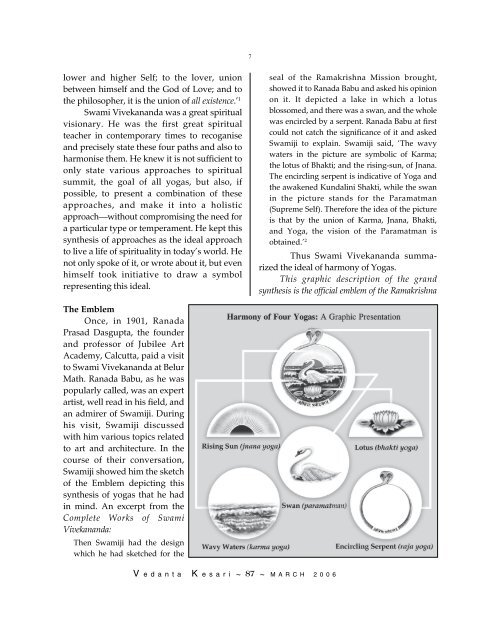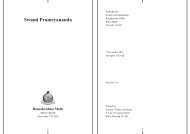Emblem of Holistic Spirituality - Belur Math
Emblem of Holistic Spirituality - Belur Math
Emblem of Holistic Spirituality - Belur Math
You also want an ePaper? Increase the reach of your titles
YUMPU automatically turns print PDFs into web optimized ePapers that Google loves.
lower and higher Self; to the lover, union<br />
between himself and the God <strong>of</strong> Love; and to<br />
the philosopher, it is the union <strong>of</strong> all existence.’ 1<br />
Swami Vivekananda was a great spiritual<br />
visionary. He was the first great spiritual<br />
teacher in contemporary times to recoganise<br />
and precisely state these four paths and also to<br />
harmonise them. He knew it is not sufficient to<br />
only state various approaches to spiritual<br />
summit, the goal <strong>of</strong> all yogas, but also, if<br />
possible, to present a combination <strong>of</strong> these<br />
approaches, and make it into a holistic<br />
approach—without compromising the need for<br />
a particular type or temperament. He kept this<br />
synthesis <strong>of</strong> approaches as the ideal approach<br />
to live a life <strong>of</strong> spirituality in today’s world. He<br />
not only spoke <strong>of</strong> it, or wrote about it, but even<br />
himself took initiative to draw a symbol<br />
representing this ideal.<br />
The <strong>Emblem</strong><br />
Once, in 1901, Ranada<br />
Prasad Dasgupta, the founder<br />
and pr<strong>of</strong>essor <strong>of</strong> Jubilee Art<br />
Academy, Calcutta, paid a visit<br />
to Swami Vivekananda at <strong>Belur</strong><br />
<strong>Math</strong>. Ranada Babu, as he was<br />
popularly called, was an expert<br />
artist, well read in his field, and<br />
an admirer <strong>of</strong> Swamiji. During<br />
his visit, Swamiji discussed<br />
with him various topics related<br />
to art and architecture. In the<br />
course <strong>of</strong> their conversation,<br />
Swamiji showed him the sketch<br />
<strong>of</strong> the <strong>Emblem</strong> depicting this<br />
synthesis <strong>of</strong> yogas that he had<br />
in mind. An excerpt from the<br />
Complete Works <strong>of</strong> Swami<br />
Vivekananda:<br />
Then Swamiji had the design<br />
which he had sketched for the<br />
V edanta K esari ~ 87 ~ MARCH 2006<br />
7<br />
seal <strong>of</strong> the Ramakrishna Mission brought,<br />
showed it to Ranada Babu and asked his opinion<br />
on it. It depicted a lake in which a lotus<br />
blossomed, and there was a swan, and the whole<br />
was encircled by a serpent. Ranada Babu at first<br />
could not catch the significance <strong>of</strong> it and asked<br />
Swamiji to explain. Swamiji said, ‘The wavy<br />
waters in the picture are symbolic <strong>of</strong> Karma;<br />
the lotus <strong>of</strong> Bhakti; and the rising-sun, <strong>of</strong> Jnana.<br />
The encircling serpent is indicative <strong>of</strong> Yoga and<br />
the awakened Kundalini Shakti, while the swan<br />
in the picture stands for the Paramatman<br />
(Supreme Self). Therefore the idea <strong>of</strong> the picture<br />
is that by the union <strong>of</strong> Karma, Jnana, Bhakti,<br />
and Yoga, the vision <strong>of</strong> the Paramatman is<br />
obtained.’ 2<br />
Thus Swami Vivekananda summarized<br />
the ideal <strong>of</strong> harmony <strong>of</strong> Yogas.<br />
This graphic description <strong>of</strong> the grand<br />
synthesis is the <strong>of</strong>ficial emblem <strong>of</strong> the Ramakrishna



